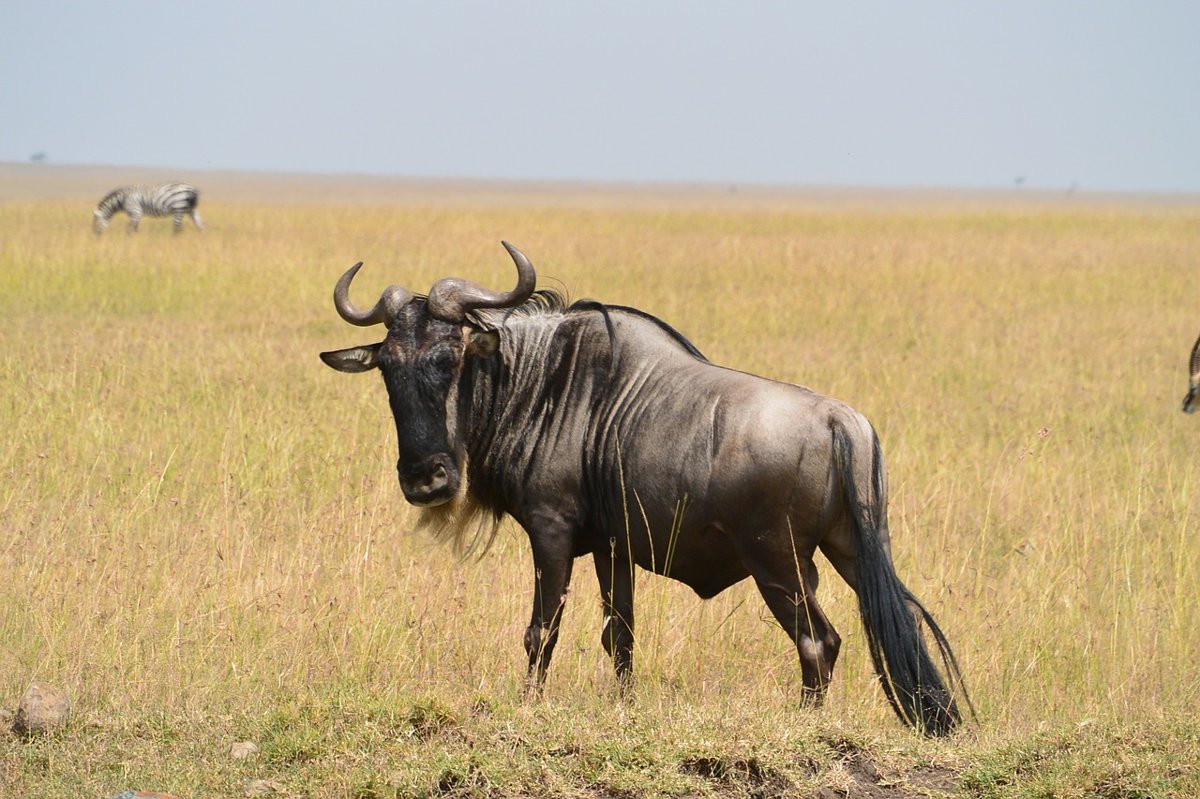THE GREAT MIGRATION: WILDEBEESTS EPIC JOURNEY
THE GREAT MIGRATION: WILDEBEESTS EPIC JOURNEY.
If I am not mistaken, I think the first time I heard the word "Wildebeests" was in Prof. Bisala's Systemic Pathology Class (It was the Malignant Cattarrhal Fever Class) and in fact, I spelt it as "Wild beasts", lol. I guess someone then asked for the spelling and that was how I corrected it. But, it got me thinking and I was like what on earth are Wildebeests again for God's sake? Boom, I decided to read about them.
Wildebeests are large hooved mammals that belong to the Bovidae family. Simply put, they look like Cows but they are not Cows. Please check pictures below.
Whilst reading about them, something caught my attention and that is the way they migrate, especially from the Serengeti (Tanzania) to the Masai Mara (Kenya). I feel that is very spectacular.
The Great Migration is one of the most spectacular wildlife events on the planet. Every year, hundreds of thousands of wildebeests, accompanied by zebras and gazelles, embark on a journey we xan all call treacherous, in search of greener pastures. It is indeed an epic tale of survival and perseverance. This is again a testament to the fact that Nature would want to whine you, but as I used to say, please do not panic.
In the scorching savannas of Tanzania's Serengeti, the Great Migration commences. The wildebeests, driven by the quest for sustenance, begin their arduous trek, a very coordinated trek. As the rains dwindle and the land begin to dry up, the herds converge, their numbers swelling to a sea of horns and hooves.
As the wildebeests traverse the unforgiving landscape, they encounter formidable obstacles. River crossings become battlegrounds, where crocodiles and treacherous currents would always threaten to claim their lives. Predators – lions, cheetahs, and hyenas – stalk their prey, exploiting every weakness. Steep slopes and rocky terrain test their agility and endurance. Nevertheless, despite all obstacles and antagonism, the sea of horns and hooves would always forge ahead. Nothing stops them. It does not matter if they lose some to the treacherous currents. It does not matter if they lose some to the ever hungry jaws of their Predators. The survivors always forge ahead, a very bold and coordinated trek.
I want to believe the question that is swelling up in you would be related to reasons for this migration. My Dear Readership, This audacious, arduous and Great Migration is a vital component of the ecosystem as it sustains the delicate balance of predator and prey. The wildebeests' journey nourishes the land, dispersing seeds and fertilizing the soil. Wildebeests migrate in search of food, water, and suitable habitats. Their migration patterns are driven by the seasonal changes. Here are few reasons why wildebeests migrate:
1. Food availability: Wildebeests migrate to areas with abundant grasses, leaves, and fruits. During the wet season, grasslands are lush and green, providing a feast for the wildebeests. As the dry season sets in, they move to areas with more abundant food sources.
2. Water availability: Wildebeests need access to water sources, especially during the dry season. They migrate to areas with reliable water sources, such as rivers, lakes, or wetlands.
3. Predator avoidance: By migrating in large herds, wildebeests reduce their vulnerability to predators like lions, cheetahs, and hyenas. But of course, they cannot avoid this totally. However, there must be a delicate balance.
4. Breeding and calving: Wildebeests migrate to specific areas with suitable habitats for breeding and calving. The females give birth in areas with abundant food and water, ensuring their newborns have the best chance of survival.
5. Climate: Wildebeests migrate to avoid harsh weather conditions, such as extreme temperatures, drought, or flooding.
6. Competition: By migrating, wildebeests avoid competition with other herbivores for limited resources.
And then their migration also supports the local economy, attracting tourists and generating revenue for conservation efforts.
My Dear Readership, The most treacherous phase of the journey unfolds at the Mara River. Wildebeests plunge into the churning waters, braving currents and carnivores. The spectacle is both heart-stopping and awe-inspiring, as the herds surmount this formidable barrier and upon reaching the Maasai Mara National Reserve, the wildebeests arrive at their destination. The calving season commences, as newborns take their first hazy steps. Vulnerable to predators, the young ones rely on their mothers' vigilance and the herd's collective protection.
In conclusion, the Great Migration is a testament to the indomitable spirit of the wildebeests, their resilience and of course their perseverance. Their epic journey reminds us of the beauty, resilience, and interconnectedness of the natural world. As we witness this wonder, let us all join hands and forces to protect, conserve, and cherish this precious heritage for generations to come.
And just as The MBN would say "till we get to the promised land, I shall be waiting for when you will pass me a glass of water and thank God for the gift of grace for this race.
If I am not mistaken, I think the first time I heard the word "Wildebeests" was in Prof. Bisala's Systemic Pathology Class (It was the Malignant Cattarrhal Fever Class) and in fact, I spelt it as "Wild beasts", lol. I guess someone then asked for the spelling and that was how I corrected it. But, it got me thinking and I was like what on earth are Wildebeests again for God's sake? Boom, I decided to read about them.
Wildebeests are large hooved mammals that belong to the Bovidae family. Simply put, they look like Cows but they are not Cows. Please check pictures below.
Whilst reading about them, something caught my attention and that is the way they migrate, especially from the Serengeti (Tanzania) to the Masai Mara (Kenya). I feel that is very spectacular.
The Great Migration is one of the most spectacular wildlife events on the planet. Every year, hundreds of thousands of wildebeests, accompanied by zebras and gazelles, embark on a journey we xan all call treacherous, in search of greener pastures. It is indeed an epic tale of survival and perseverance. This is again a testament to the fact that Nature would want to whine you, but as I used to say, please do not panic.
In the scorching savannas of Tanzania's Serengeti, the Great Migration commences. The wildebeests, driven by the quest for sustenance, begin their arduous trek, a very coordinated trek. As the rains dwindle and the land begin to dry up, the herds converge, their numbers swelling to a sea of horns and hooves.
As the wildebeests traverse the unforgiving landscape, they encounter formidable obstacles. River crossings become battlegrounds, where crocodiles and treacherous currents would always threaten to claim their lives. Predators – lions, cheetahs, and hyenas – stalk their prey, exploiting every weakness. Steep slopes and rocky terrain test their agility and endurance. Nevertheless, despite all obstacles and antagonism, the sea of horns and hooves would always forge ahead. Nothing stops them. It does not matter if they lose some to the treacherous currents. It does not matter if they lose some to the ever hungry jaws of their Predators. The survivors always forge ahead, a very bold and coordinated trek.
I want to believe the question that is swelling up in you would be related to reasons for this migration. My Dear Readership, This audacious, arduous and Great Migration is a vital component of the ecosystem as it sustains the delicate balance of predator and prey. The wildebeests' journey nourishes the land, dispersing seeds and fertilizing the soil. Wildebeests migrate in search of food, water, and suitable habitats. Their migration patterns are driven by the seasonal changes. Here are few reasons why wildebeests migrate:
1. Food availability: Wildebeests migrate to areas with abundant grasses, leaves, and fruits. During the wet season, grasslands are lush and green, providing a feast for the wildebeests. As the dry season sets in, they move to areas with more abundant food sources.
2. Water availability: Wildebeests need access to water sources, especially during the dry season. They migrate to areas with reliable water sources, such as rivers, lakes, or wetlands.
3. Predator avoidance: By migrating in large herds, wildebeests reduce their vulnerability to predators like lions, cheetahs, and hyenas. But of course, they cannot avoid this totally. However, there must be a delicate balance.
4. Breeding and calving: Wildebeests migrate to specific areas with suitable habitats for breeding and calving. The females give birth in areas with abundant food and water, ensuring their newborns have the best chance of survival.
5. Climate: Wildebeests migrate to avoid harsh weather conditions, such as extreme temperatures, drought, or flooding.
6. Competition: By migrating, wildebeests avoid competition with other herbivores for limited resources.
And then their migration also supports the local economy, attracting tourists and generating revenue for conservation efforts.
My Dear Readership, The most treacherous phase of the journey unfolds at the Mara River. Wildebeests plunge into the churning waters, braving currents and carnivores. The spectacle is both heart-stopping and awe-inspiring, as the herds surmount this formidable barrier and upon reaching the Maasai Mara National Reserve, the wildebeests arrive at their destination. The calving season commences, as newborns take their first hazy steps. Vulnerable to predators, the young ones rely on their mothers' vigilance and the herd's collective protection.
In conclusion, the Great Migration is a testament to the indomitable spirit of the wildebeests, their resilience and of course their perseverance. Their epic journey reminds us of the beauty, resilience, and interconnectedness of the natural world. As we witness this wonder, let us all join hands and forces to protect, conserve, and cherish this precious heritage for generations to come.
And just as The MBN would say "till we get to the promised land, I shall be waiting for when you will pass me a glass of water and thank God for the gift of grace for this race.


